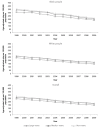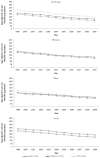Urban-rural differences in coronary heart disease mortality in the United States: 1999-2009
- PMID: 24381356
- PMCID: PMC3863000
- DOI: 10.1177/003335491412900105
Urban-rural differences in coronary heart disease mortality in the United States: 1999-2009
Abstract
Objective: Coronary heart disease (CHD) mortality has declined in the past few decades; however, it is unclear whether the reduction in CHD deaths has been similar across urbanization levels and in specific racial groups. We describe the pattern and magnitude of urban-rural variations in CHD mortality in the U.S.
Methods: Using data from the National Center for Health Statistics, we examined trends in death rates from CHD from 1999 to 2009 among people aged 35-84 years, in each geographic region (Northeast, Midwest, West, and South) and in specific racial-urbanization groups, including black and white people in large and medium metropolitan (urban) areas and in non-metropolitan (rural) areas. We also examined deaths from early-onset CHD in females aged <65 years and males aged <55 years.
Results: From 1999 to 2009, there was a 40% decline in age-adjusted CHD mortality. The trend was similar in black and white people but was more pronounced in urban than in rural areas, resulting in a crossover in 2007, when rural areas began showing a higher CHD mortality than urban areas. White people in large metropolitan areas had the largest decline (43%). Throughout the study period, CHD mortality remained higher in black people than in white people, and, in the South, it remained higher in rural than in urban areas. For early-onset CHD, the mortality decline was more modest (30%), but overall trends by urbanization and region were similar.
Conclusion: Favorable national trends in CHD mortality conceal persisting disparities for some regions and population subgroups (e.g., rural areas and black people).
Figures





References
-
- Minino AM. Death in the United States, 2009. NCHS Data Brief. 2011;(64):1–8. - PubMed
-
- Hunink MG, Goldman L, Tosteson AN, Mittleman MA, Goldman PA, Williams LW, et al. The recent decline in mortality from coronary heart disease, 1980–1990. The effect of secular trends in risk factors and treatment. JAMA. 1997;277:535–42. - PubMed
-
- Goldman L, Cook EF. The decline in ischemic heart disease mortality rates. An analysis of the comparative effects of medical interventions and changes in lifestyle. Ann Intern Med. 1984;101:825–36. - PubMed
-
- Kaplan GA, Cohn BA, Cohen RD, Guralnik J. The decline in ischemic heart disease mortality: prospective evidence from the Alameda County Study. Am J Epidemiol. 1988;127:1131–42. - PubMed
MeSH terms
LinkOut - more resources
Full Text Sources
Other Literature Sources
Miscellaneous

